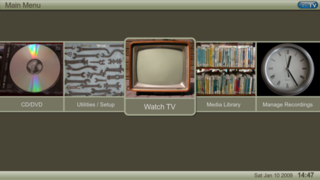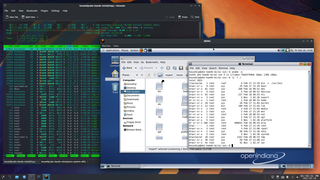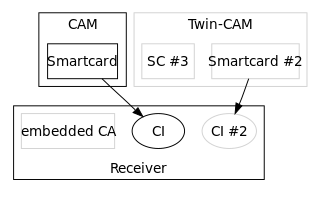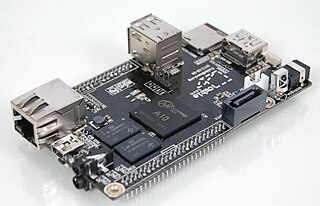A digital video recorder (DVR), also referred to as a personal video recorder (PVR) particularly in Canadian and British English, is an electronic device that records video in a digital format to a disk drive, USB flash drive, SD memory card, SSD or other local or networked mass storage device. The term includes set-top boxes (STB) with direct to disk recording, portable media players and TV gateways with recording capability, and digital camcorders. Personal computers are often connected to video capture devices and used as DVRs; in such cases the application software used to record video is an integral part of the DVR. Many DVRs are classified as consumer electronic devices. Similar small devices with built-in displays and SSD support may be used for professional film or video production, as these recorders often do not have the limitations that built-in recorders in cameras have, offering wider codec support, the removal of recording time limitations and higher bitrates.

MythTV is a free and open-source home entertainment application with a simplified "10-foot user interface" design for the living room TV. It turns a computer with the necessary hardware into a network streaming digital video recorder, a digital multimedia home entertainment system, or home theater personal computer. It can be considered a free and open-source alternative to TiVo or Windows Media Center. It runs on various operating systems, primarily Linux, macOS, and FreeBSD.

Hauppauge Computer Works is a US manufacturer and marketer of electronic video hardware for personal computers. Although it is most widely known for its WinTV line of TV tuner cards for PCs, Hauppauge also produces personal video recorders, digital video editors, digital media players, hybrid video recorders and digital television products for both Windows and Mac. The company is named after the hamlet of Hauppauge, New York, in which it is based.
A DVD recorder is an optical disc recorder that uses optical disc recording technologies to digitally record analog or digital signals onto blank writable DVD media. Such devices are available as either installable drives for computers or as standalone components for use in television studios or home theater systems.

The Quick Emulator (QEMU) is a free and open-source emulator that uses dynamic binary translation to emulate a computer's processor; that is, it translates the emulated binary codes to an equivalent binary format which is executed by the machine. It provides a variety of hardware and device models for the virtual machine, enabling it to run different guest operating systems. QEMU can be used with a Kernel-based Virtual Machine (KVM) to emulate hardware at near-native speeds. Additionally, it supports user-level processes, allowing applications compiled for one processor architecture to run on another.
Neuros Technology was a Chicago, Illinois–based company that produced a number of audio and video devices under the brand name Neuros. Founded by Joe Born in 2001 as a division of Digital Innovations, it previously operated under the name Neuros Audio. Like Digital Innovations, Neuros distinguished itself by its use of open-innovation and crowdsourcing techniques to bring products to market, as well as by its prominent use of open-source software and open-source hardware. In its development model, end users were involved throughout the product development process from reviewing initial concepts to beta testing initial product releases.

In Digital Video Broadcasting (DVB), the Common Interface is a technology which allows decryption of pay TV channels. Pay TV stations want to choose which encryption method to use. The Common Interface allows TV manufacturers to support many different pay TV stations, by allowing to plug in exchangeable conditional-access modules (CAM) for various encryption schemes.

Moxi was a line of high-definition digital video recorders produced by Moxi Digital Digeo and Arris International. Moxi was originally released only to cable operators, but in December 2008 it was released as a retail product. Moxi was removed from the market in November 2011. The former retail product, the Moxi HD DVR, provided a high-definition user interface with support for either two or three CableCARD TV tuners. Arris also offered a companion appliance, the Moxi Mate, which could stream live or recorded TV from a Moxi HD DVR.

Dreambox is a series of Linux-powered DVB satellite, terrestrial and cable digital television receivers, produced by German multimedia vendor Dream Multimedia.
The Hauppauge MediaMVP is a network media player. It consists of a hardware unit with remote control, along with software for a Windows PC. Out of the box, it is capable of playing video and audio, displaying pictures, and "tuning in" to Internet radio stations. Alternative software is also available to extend its capabilities. It can be used as a front-end for various PVR projects.

The Pepper Pad was a family of Linux-based mobile computers with Internet capability and which doubled as a handheld game console. They also served as a portable multimedia device. The devices used Bluetooth and Wi-Fi technologies for Internet connection. Pepper Pads are now obsolete, unsupported and the parent company has ceased operations.

A free-to-air or FTA Receiver is a satellite television receiver designed to receive unencrypted broadcasts. Modern decoders are typically compliant with the MPEG-4/DVB-S2 standard and formerly the MPEG-2/DVB-S standard, while older FTA receivers relied on analog satellite transmissions which have declined rapidly in recent years.
The Eurovox is a Digital Cable set-top box, notoriously known for its ability to decode cable television services without a subscription, which has been imported into the UK from Korea since 2004.
The Vu+, is a series of Linux-powered DVB satellite, terrestrial digital television receivers, produced by Korean multimedia brand Ceru Co., Ltd.
Unibox is a satellite, cable and terrestrial digital receiver. It has been distributed widely for use with Pay TV. It also enables the receiver to store digital copies of MPEG TS on internal harddisk or networked filesystems.

The Allwinner A1X is a family of single-core SoC devices designed by Allwinner Technology from Zhuhai, China. Currently the family consists of the A10, A13, A10s and A12. The SoCs incorporate the ARM Cortex-A8 as their main processor and the Mali 400 as the GPU.

Tuxera Inc. is a Finnish company that develops and sells file systems, flash management and networking software. The company was founded in 2008 and is headquartered in Espoo, Finland. Tuxera's other offices are located in the US, South Korea, Japan, Hungary, Germany, Taiwan and China.
Enigma2, the second generation of Enigma software, is an application used in Linux-based Digital Video Broadcasting receivers or TV set-top boxes and Internet Protocol television receivers. It creates a graphical user interface to control the said devices using a remote control and provides features such as tuning available satellite transponders, cable channels and terrestrial television transmitters or accessing material via Internet Protocol television (IPTV), watching a TV program or listening to radio, time shifting, Digital video recorder, streaming media programs to other devices, etc. Other features are available through plugins – for example Electronic program guide (EPG), Hybrid Broadcast Broadband TV (HbbTV), access to TV archives and movie databases, playback of multimedia files, viewing photos, etc.
E2 Linux is an umbrella name for Linux distributions designed to control digital television receivers, set-top boxes and IPTV receivers. E2 Linux was originally developed for Dreambox receivers, but after 2010 a number of other manufacturers began shipping devices with E2 Linux, including Formuler, GigaBlue, Octagon, Opticum, Unibox, Vu+, and Zgemma.











